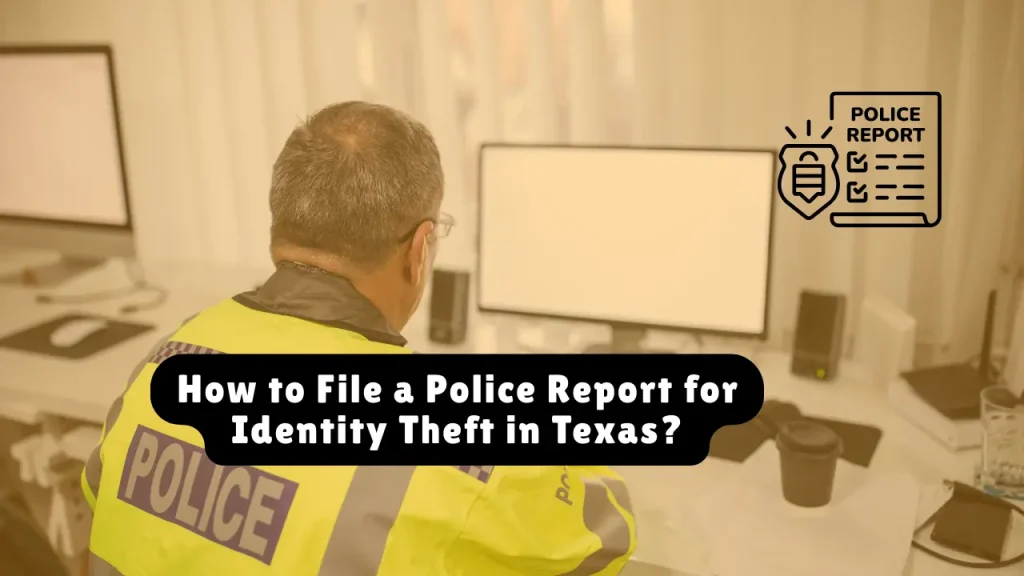How to File a Police Report for Identity Theft in Texas? (2025 Guide)
Identity theft in Texas is not just a financial inconvenience—it’s a serious criminal offense under Texas law. Victims must take swift legal and financial steps to protect themselves. Filing a police report is the foundation for disputing fraudulent charges, freezing your credit, and restoring your financial identity.
Whether you’re in Dallas, Fort Worth, Austin, Houston, or rural counties like Bexar, this step-by-step guide walks you through the entire identity theft reporting process in Texas—including required documentation, agency contacts, legal remedies, and what to expect afterward.
Table of Contents
Understanding Identity Theft Under Texas Law
Under Texas Penal Code § 32.51, identity theft occurs when someone “obtains, possesses, transfers, or uses” another individual’s personally identifying information (PII) without consent and with the intent to harm or defraud.
Penalties depend on the value of the fraud:
- Class B misdemeanor: Less than $1,500 in harm
- Felony (up to second-degree): Over $300,000 in losses
(Source: Texas Attorney General)
Step 1: Gather Essential Documentation
Before reporting the crime, you must compile evidence that supports your claim. Here’s what you’ll need:
✅ FTC Identity Theft Report
Submit your case at IdentityTheft.gov to receive an official affidavit and personalized recovery plan.
✅ Proof of Fraud
Collect:
- Bank and credit card statements
- Credit reports (Equifax, Experian, TransUnion)
- Debt collection letters
- Loan or account applications opened fraudulently
Government-Issued ID
A color copy of your driver’s license, passport, or Texas state ID is required.
Supporting Correspondence
Include any emails, rejection letters, or prior communications with creditors or law enforcement.
Tip: Organize these into a labeled binder or digital folder, grouped by date and type.
Read more: Do Police Actually Investigate Identity Theft?

Step 2: File a Police Report with the Right Agency
You must file with the law enforcement agency where you live or where the crime occurred. Texas doesn’t centralize this process—procedures vary by city or county.
Major Cities in Texas
Fort Worth
- File online using the free Fraud Report Portal
- Get printable confirmation upon submission
Austin
- Use the MyCaseNumber system (for residents 17+ with email)
- Select “Identity Theft” under non-emergency reports
Houston
- Call HPD Teleserve Unit at (713) 884-3131
- Update existing cases via the Cyber & Financial Crimes Division: (713) 308-2500
Dallas
- Use the Citizen Online Reporting System
- Submit the Identity Theft Complaint Form, FTC report, ID, and fraud evidence
- For mistaken arrests, contact the Dallas City Attorney’s Office (2014 Main Street) to file an “Affidavit of Wrong Person Cited”
Carrollton
- File in-person at the police station front desk
- Or use the Citizens Online Reporting Portal (select “Identity Fraud”)
Read also: What Does the FBI Do About Identity Theft?
Bexar County / San Antonio
- Report to the Bexar County Sheriff’s Office or the SAPD Financial Crimes Unit
- Bring original documents and photocopies
League City
- Provides a downloadable Victim’s Kit and FAQs
- Calls must go through the local police non-emergency number
Statewide (Texas Department of Public Safety)
- File via iWatchTX.org
- For follow-up, contact local DPS branches directly
Step 3: Submit Your Report
No matter the location or method, follow this standard process:
- Initiate Contact: Choose online, phone, or in-person reporting.
- Provide Personal Details: Full name, date of birth, address, and theft description.
- Submit Evidence: Upload or hand in copies. Retain originals.
- Request a Report Number: Always ask for a printed or PDF copy with the officer’s contact.
- Clarify Next Steps: Ask about investigation timelines, certified copies, and follow-ups.
Step 4: What Happens After You File?
Case Number Issuance
- Usually immediate for online filings
- Within 24 hours for in-person or phone submissions
Investigator Assignment
- Typically within 7–14 days, though times may vary
Certified Copies of Report
- May cost $5–$15
- Available within 1–5 days from the Records Division
Step 5: Notify Additional Agencies
Credit Bureaus
Place fraud alerts (valid for 1 year) or credit freezes (free and permanent unless lifted):
- Equifax: 1-800-525-6285 | equifax.com
- Experian: 1-888-397-3742 | experian.com
- TransUnion: 1-800-680-7289 | transunion.com
Financial Institutions
Send the report to your:
- Bank
- Credit card issuer
- Loan provider
- Utility company
Also notify check verification companies like SCAN: 1-800-262-7771
IRS
For tax-related identity theft, call 1-800-908-4490
FTC
Submit your police report to the National Identity Theft Database, helping federal investigators track trends.
Step 6: Seek Legal Remedies
Obtain a Court Order
You can petition a Texas District Court for a Declaration of Identity Theft—a legal order requiring businesses and government agencies to fix fraud records.
Report Data Breaches
If the theft occurred due to a company’s data mishandling, file a complaint under the Texas Identity Theft Enforcement and Protection Act via the Texas AG’s Office.
Step 7: Prevention & Ongoing Protection
Fraud Alerts & Freezes
Both are covered under the Fair Credit Reporting Act (FCRA) and can block unauthorized credit applications.
Monitor Accounts Regularly
Use services like Aura, LifeLock, or your bank’s credit monitoring tools.
Shred Documents
Destroy financial mail, old IDs, and receipts to prevent dumpster diving.
Best Practices
- Use strong passwords and multi-factor authentication
- Secure mailboxes and online accounts
- Avoid oversharing personal info
Special Populations & Accessibility
- Non-English Speakers: Language options available on most portals; request interpreters in person.
- Minors or Incapacitated Adults: Guardians can file with proof of authority.
- Disabled Victims: Request ADA accommodations for mobility, visual, or hearing needs.
Escalation Tips if No Response
If no investigator responds within 14 days:
- Call the non-emergency number of the reporting agency.
- File a complaint with:
- Consumer Financial Protection Bureau (CFPB)
- Texas Attorney General’s Office
- Consumer Financial Protection Bureau (CFPB)
- Seek help from the Texas Crime Victims’ Compensation Program for legal aid or restitution.
Final Thoughts: Reclaim Control Now
Filing a police report for identity theft in Texas is not just a formality—it’s your legal shield and financial recovery blueprint. From Fort Worth’s digital portal to Bexar County’s in-person procedures, Texas provides multiple avenues to protect your identity.
Take immediate action:
- Collect your documents
- File with your local agency
- Follow up with credit bureaus and banks
- Use state legal tools to clear your name
For more help, visit:
Key Takeaway:
Act quickly. Document thoroughly. Use every legal and administrative tool Texas offers to reclaim your financial identity and peace of mind.Identity theft in Texas is not just a financial inconvenience—it’s a serious criminal offense under Texas law. Victims must take swift legal and financial steps to protect themselves. Filing a police report is the foundation for disputing fraudulent charges, freezing your credit, and restoring your financial identity.
Whether you’re in Dallas, Fort Worth, Austin, Houston, or rural counties like Bexar, this step-by-step guide walks you through the entire identity theft reporting process in Texas—including required documentation, agency contacts, legal remedies, and what to expect afterward.
Understanding Identity Theft Under Texas Law
Under Texas Penal Code § 32.51, identity theft occurs when someone “obtains, possesses, transfers, or uses” another individual’s personally identifying information (PII) without consent and with the intent to harm or defraud.
Penalties depend on the value of the fraud:
- Class B misdemeanor: Less than $1,500 in harm
- Felony (up to second-degree): Over $300,000 in losses
(Source: Texas Attorney General)
Step 1: Gather Essential Documentation
Before reporting the crime, you must compile evidence that supports your claim. Here’s what you’ll need:
✅ FTC Identity Theft Report
Submit your case at IdentityTheft.gov to receive an official affidavit and personalized recovery plan.
✅ Proof of Fraud
Collect:
- Bank and credit card statements
- Credit reports (Equifax, Experian, TransUnion)
- Debt collection letters
- Loan or account applications opened fraudulently
Government-Issued ID
A color copy of your driver’s license, passport, or Texas state ID is required.
Supporting Correspondence
Include any emails, rejection letters, or prior communications with creditors or law enforcement.
Tip: Organize these into a labeled binder or digital folder, grouped by date and type.
Step 2: File a Police Report with the Right Agency
You must file with the law enforcement agency where you live or where the crime occurred. Texas doesn’t centralize this process—procedures vary by city or county.
Major Cities in Texas
Fort Worth
- File online using the free Fraud Report Portal
- Get printable confirmation upon submission
Austin
- Use the MyCaseNumber system (for residents 17+ with email)
- Select “Identity Theft” under non-emergency reports
Houston
- Call HPD Teleserve Unit at (713) 884-3131
- Update existing cases via the Cyber & Financial Crimes Division: (713) 308-2500
Dallas
- Use the Citizen Online Reporting System
- Submit the Identity Theft Complaint Form, FTC report, ID, and fraud evidence
- For mistaken arrests, contact the Dallas City Attorney’s Office (2014 Main Street) to file an “Affidavit of Wrong Person Cited”
Carrollton
- File in-person at the police station front desk
- Or use the Citizens Online Reporting Portal (select “Identity Fraud”)
Bexar County / San Antonio
- Report to the Bexar County Sheriff’s Office or the SAPD Financial Crimes Unit
- Bring original documents and photocopies
League City
- Provides a downloadable Victim’s Kit and FAQs
- Calls must go through the local police non-emergency number
Statewide (Texas Department of Public Safety)
- File via iWatchTX.org
- For follow-up, contact local DPS branches directly
Step 3: Submit Your Report
No matter the location or method, follow this standard process:
- Initiate Contact: Choose online, phone, or in-person reporting.
- Provide Personal Details: Full name, date of birth, address, and theft description.
- Submit Evidence: Upload or hand in copies. Retain originals.
- Request a Report Number: Always ask for a printed or PDF copy with the officer’s contact.
- Clarify Next Steps: Ask about investigation timelines, certified copies, and follow-ups.
Step 4: What Happens After You File?
Case Number Issuance
- Usually immediate for online filings
- Within 24 hours for in-person or phone submissions
Investigator Assignment
- Typically within 7–14 days, though times may vary
Certified Copies of Report
- May cost $5–$15
- Available within 1–5 days from the Records Division
Step 5: Notify Additional Agencies
Credit Bureaus
Place fraud alerts (valid for 1 year) or credit freezes (free and permanent unless lifted):
- Equifax: 1-800-525-6285 | equifax.com
- Experian: 1-888-397-3742 | experian.com
- TransUnion: 1-800-680-7289 | transunion.com
Financial Institutions
Send the report to your:
- Bank
- Credit card issuer
- Loan provider
- Utility company
Also notify check verification companies like SCAN: 1-800-262-7771
IRS
For tax-related identity theft, call 1-800-908-4490
FTC
Submit your police report to the National Identity Theft Database, helping federal investigators track trends.
Step 6: Seek Legal Remedies
Obtain a Court Order
You can petition a Texas District Court for a Declaration of Identity Theft—a legal order requiring businesses and government agencies to fix fraud records.
Report Data Breaches
If the theft occurred due to a company’s data mishandling, file a complaint under the Texas Identity Theft Enforcement and Protection Act via the Texas AG’s Office.
Step 7: Prevention & Ongoing Protection
Fraud Alerts & Freezes
Both are covered under the Fair Credit Reporting Act (FCRA) and can block unauthorized credit applications.
Monitor Accounts Regularly
Use services like Aura, LifeLock, or your bank’s credit monitoring tools.
Shred Documents
Destroy financial mail, old IDs, and receipts to prevent dumpster diving.
Best Practices
- Use strong passwords and multi-factor authentication
- Secure mailboxes and online accounts
- Avoid oversharing personal info
Special Populations & Accessibility
- Non-English Speakers: Language options available on most portals; request interpreters in person.
- Minors or Incapacitated Adults: Guardians can file with proof of authority.
- Disabled Victims: Request ADA accommodations for mobility, visual, or hearing needs.
Escalation Tips if No Response
If no investigator responds within 14 days:
- Call the non-emergency number of the reporting agency.
- File a complaint with:
- Consumer Financial Protection Bureau (CFPB)
- Texas Attorney General’s Office
- Consumer Financial Protection Bureau (CFPB)
- Seek help from the Texas Crime Victims’ Compensation Program for legal aid or restitution.
Final Thoughts: Reclaim Control Now
Filing a police report for identity theft in Texas is not just a formality—it’s your legal shield and financial recovery blueprint. From Fort Worth’s digital portal to Bexar County’s in-person procedures, Texas provides multiple avenues to protect your identity.
Take immediate action:
- Collect your documents
- File with your local agency
- Follow up with credit bureaus and banks
- Use state legal tools to clear your name
For more help, visit:
Key Takeaway:
Act quickly. Document thoroughly. Use every legal and administrative tool Texas offers to reclaim your financial identity and peace of mind.
About the Author

Sarah Klein, JD, is a former consumer rights attorney who spent years helping clients with issues like unfair billing, product disputes, and debt collection practices. At All About Lawyer, she simplifies consumer protection laws so readers can defend their rights and resolve problems with confidence.
Read more about Sarah
